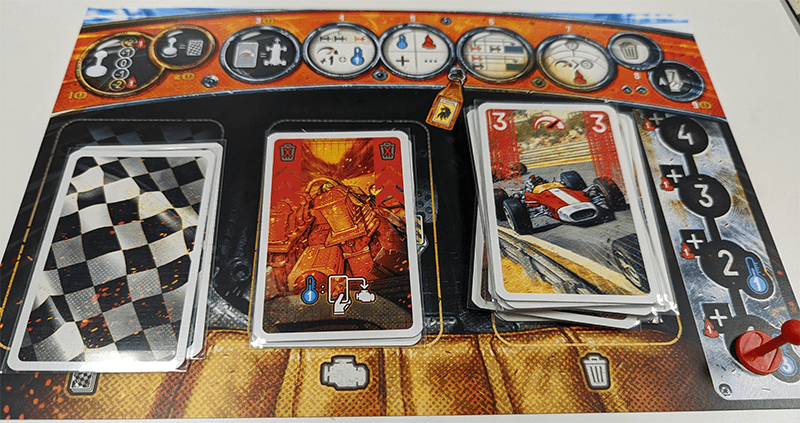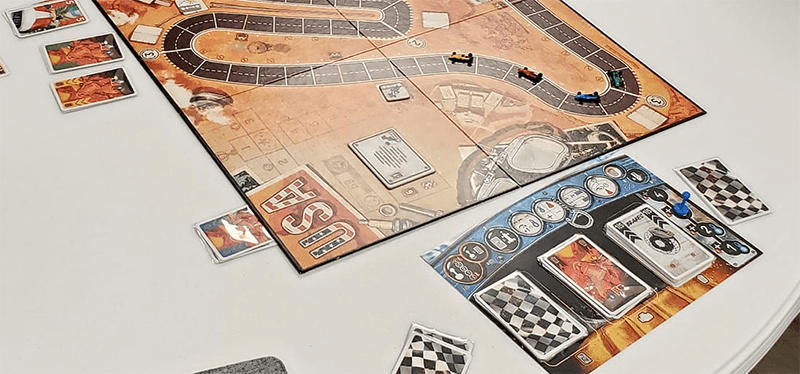Before I dived into board games, I was an avid video gamer, and one of my favorite genres was arcade racing games like Top Gear for the Super Nintendo.
When I immigrated to this colored cardboard land known as board games, one of the first games I acquired was Formula Dé. That was a mistake. Roll to move, hours to finish, and as exciting as unsalted Wheat Thins.
Despite not being satisfied with Formula Dé, I continued trying different racing games. I played Thunder Alley and liked it, but didn’t love it. A friend then introduced me to Race! Formula 90, an overly complex Formula racing game that required me to use a whiteboard to know whether my car had made the corner.
When I learned that Heat: Pedal to the Metal (now just called Heat) was coming out, I was intrigued. It was developed by the same people behind Flamme Rouge, a bike racing game where you used cards to move your cyclists instead of dice or complex rules. I wasn’t a fan of Flamme Rouge not because of its concept but its execution. The game felt far too simple for my tastes, and I was hoping Heat would give it the gas it needed.
It’s time we wave the flag down and get this going.

Wear your chain belt and polka-dot fabrics
Heat is a game based on 1960s Formula racing. Hopefully, with that simple sentence alone you know the goal. There’s a finish line; cross it before everyone else and you win. Done.
Of course, to move that little car of yours, you need speed and gears. Before anyone moves, all players have to select a gear they want to use and place down their chosen cards from their hand of 7. The gear, which goes from 1 to 4, represents how many cards you must play. Your personal deck will have Heat cards, Stress cards, and Number cards.
After all players have played their cards face down, the player in the first position will reveal their cards and move down the track according to the Number cards they played. The second player will do the same, and so forth. Stress cards handle differently: Flip the top card of the deck and if it is a number card from 1 to 4, the player can move that number of spaces. Discard any other card and the player must draw again until they get a number card from 1 to 4.
One may wonder why they would play a Stress card, and the answer is simple: they have to. At the end of their turn, players can discard unwanted cards from their hand and draw back up to 7 cards, except they cannot discard their Stress or Heat cards. You must play Stress cards to get rid of them.
Fast corners
Track corners play an important role in racing board games, and Heat handles them easily. Each corner has a line with a number above it, and when a player crosses that line, they must compare their current speed with the corner speed. If their speed is the same or lower than the corner speed, they can continue as normal.
However, if their speed is higher, they must pay the difference by spending Heat cards from their engine. Don’t have the Heat? You spin out, switch back to the first gear, and you have more Stress cards.
Heat is an important resource in this game. Players start with a stockpile of six Heat cards in their “engine” and one Heat card in their deck. Whenever they “spend” Heat, they move it from their engine to their discard pile, which is shuffled back into their deck when they need to draw more cards. Heat cards in a player’s hand cannot be discarded, and players must “cooldown” by either being in first or second gear, or in the last position on the track in order to get rid of them.
Heat isn’t just used to mad dash around corners. You can spend Heat to boost yourself by flipping a card, identical to playing a Stress card. When you switch gears, you can only move up or down one position, yet you can spend Heat to move an extra position.
Another rule is slipstreaming, which allows players to move two extra spaces for free when they end their movement next to or behind an opponent. The best part about slipstreaming is the extra movement does not count against the corner speed.
And yeah, those are the rules. Pick your gear, play cards facedown, reveal them, move your cars, decide if you want to boost or not, slipstream if possible, and check corner speed. Overall, the game is straightforward, especially compared to other games in the industry that complicate simple concepts.
I have a lot to say about Heat. For one, I don’t feel like I’m racing here, at least with a vehicle.

Let’s not go 88 MPH
When I press the gas pedal in a car, I move forward. Press it a little harder, and the car moves forward faster. Because Heat uses a hand of cards to determine your speed options, the results end up completely off. You can be in the third gear and move slower than a turtle’s corpse, or be in the first gear and somehow become a scientific breakthrough on the track. It’s bonkers.
I understand the designer’s intentions here. Heat takes place in the 1960s racing. During this period, safety standards were more of a suggestion than a requirement. To emphasize this, the randomized card draws represent the instability of the 1960s racing car while the Heat cards represent the limitations of these machines. You are supposed to push the cars to their absolute limit, but don’t go overboard. Instability is the driving force here.
Yet deciding on what to do on your turn makes little sense from a race driver’s perspective. You don’t think about “potential” speeds in the future or what you have played in the past. You don’t hope that you fix your car while driving. It’s completely disconnected.
However, just because I say that, it doesn’t mean I don’t like it. Compared to other racing board games, this is one of the most engaging and intuitive systems out there. All the planning is done simultaneously with every player and once the cards are placed facedown, the game plays by itself with the only player decisions being boost and slipstream. Managing your Heat is the core feature since you want to abuse it, but not too much. It’s a clever union of hand and risk management that any player can grasp at first glance.
Please sir, can I have some more?
I will admit the first few games I played were genuine fun experiences. Almost every time I brought this out with a new group, they’d ask for seconds like grade school children in a cafeteria. In short, Heat has one hell of a honeymoon phase.
Something occurred when I played around the fourth or fifth time with a particular veteran group of board gamers. Our races were always close, with players’ positions constantly changing like they were desperate politicians. In fact, the races were a little too close.
Every single race ended exactly the same. All the cars would fly through the last corner, perhaps one or two spaces apart. Everyone would be set to fourth gear, play their highest cards, and blaze through that finish line. One Heat card was always in reserve and we used it to boost our fifth and final speed card. Literally flipping a card won races.
This trend just kept happening over and over and over again. After some post-game discussion, we came to one simple conclusion that will probably annoy fans of this game and the designer of Heat: We felt the game was too easy.

Outta gas
Most of the rounds played were quite obvious. If you’re on a long straight, you want to be in high gear with high-numbered cards. No Heat in your hand? Very little reason to be in the first or second gear unless you can’t make it through the corner safely. You also want to spend Heat to give you the edge. Yet you can’t control when you can cooldown your hand because of the random nature of card draws.
Not that there aren’t any areas to decide on. You still need to figure out when to spend that Heat. When Stress cards enter your hand, you need to get rid of them before they occupy a good portion of your hand. Slipstreaming is no joke, and you want to predict your opponent’s movement by examining the Heat in their engine and what gear they are in.
These are interesting decisions, but these choices alone don’t carry the game. In some strange way, Heat suffers from the same problems as the designer’s previous game, Flamme Rouge. Both Heat and Flamme Rouge have this amazing baseline and barely go beyond it. Well, not exactly true. Heat has a second rulebook.
The second rulebook introduces various advanced modules to inject into your sessions of Heat. Yes, we’re going to cover every one of them.
Now this is F1 racing!
I started playing The Legends module when I wanted to learn the rules of the game before teaching others. The module adds bots to the racing grid, making it great for solo games or games with two or three players. Although I rarely play solo games, I’ve found this module to be really well done and I sometimes play it. I won’t go into technical details, but I will say that it’s easy to understand and requires minimal maintenance on your part. My only complaint is the difficulty is inconsistent as it can be much harder or easier depending on the track.
The Weather module introduces weather effects to the track. You have your “main” weather such as fog, rain, sun, or clouds, that determine your starting conditions, such as starting Heat or Stress cards. Each sector will also have its own rule based on random tiles, which can range from reducing the speed of a corner to granting free boosts in a sector. While the ideas behind this module are great, it’s easy to figure out the solution to these weather effects, leading to everyone making the same decisions.
The Garage module is where Heat shows its true colors without restraint. In the base game, your starting deck has “starting upgrade” cards of one Heat, a zero, and a five card. Ditch those out because you are now going through three rounds of card drafting where you mix and match 48 different upgrades. With these upgrades, you won’t just see numbers, but also icons. Icons mean mechanisms.
These new mechanisms are all over the map. You have some basics like paying heat or cooldown, then you get the more interesting ones like discarding stress from your hand, putting a card on top of your deck, discarding your top cards, or adjusting the corner speed. Going through a game round is no longer as straightforward as the basic game.

Turning up the Heat (not sorry)
Because of these new tools to mess around with, it gives players a sense of identity on the track and certainly makes sense from a thematic standpoint. Real race drivers will request adjustments to their racing cars depending on the track and weather. Doing a drafting phase before the start of the race emulates this experience quite well.
It also allows the players to take part in the dumbest of races and I don’t mean that as a derogatory statement. I still remember the Yellow player playing two Four Wheel drive cards and a stress card, meaning seven blind draws, and somehow hitting 22 spaces without hitting a corner. Another one was a Blue car using Wing and Tire cards that cut through the racing line so clean that The Gambinos hired a hit on him. Then there was me, who went for engine upgrades that generated heat for high-risk plays that did not pay out. Let’s just say my car hosted a gender reveal party during a very important straight section and set itself on fire.
The final module in this game is the Championship module, which allows players to take part in a season of races. I have only played this once with the Legends module, but it was a truly impressive experience that combined elements from the previous modules. Weather conditions are still in effect and players receive one upgrade card per race.
The major differences in this module are the inclusion of Sponsorship cards and Event cards. Sponsorship cards are like Upgrade cards, but you can only use them once. Event cards add special conditions to the race, such as changing the number of laps or hand size. It’s like being part of an interactive racing story where you are the protagonist. While I have only played this once, I found it to be a well-designed and engaging experience.
Actually, that describes Heat well. I’ve played very few games in 2022 that are this well-designed. It ranks among the best racing board games I’ve played, even in its basic form. With its advanced modules, it takes the pole position with ease, and I don’t see any other racing game coming close to it.












Excellent review, Mark! We recently purchased this game and we were very encouraged by your honest review. Merry Christmas!
You touched on what I didn’t like about this game in your review, but other players seem to get over it as they play or simply not let it bother them from the beginning. It felt like managing a hand of cards and not like auto racing.